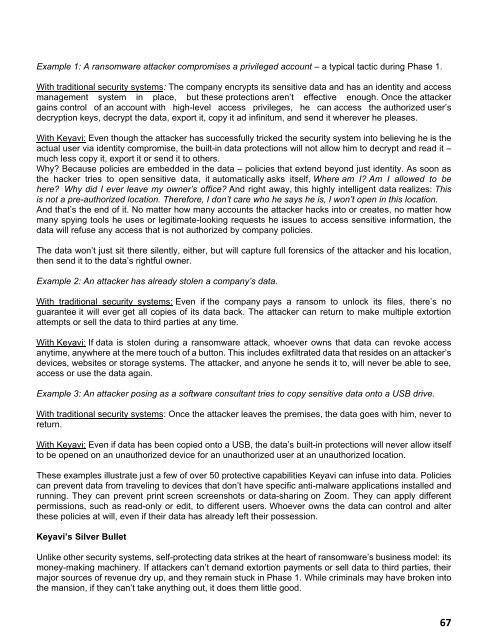The Black Unicorn Report for 2021
In this Black Unicorn Report for 2021, we’ve taken a few unique cybersecurity lenses to view the market and predict the future. Note that post COVID-19, the world has turned upside down and it’s accelerated telecommuting and cloud-based apps (SaaS) expansion, moving us from 3-4% home workforce to over 51% and growing. Thus, the major attack vectors have shifted to the cloud and weaker home-computing hygiene. This has opened doors for increased revenues and visibility among those players who secure the cloud, SaaS apps and deal with weak, remote, exposed endpoints. Learn about the winners and finalists in seven key categories and get one step ahead of the next threat with their help.
In this Black Unicorn Report for 2021, we’ve taken a few unique cybersecurity lenses to view the market and predict the future. Note that post COVID-19, the world has turned upside down and it’s accelerated telecommuting and cloud-based apps (SaaS) expansion, moving us from 3-4% home workforce to over 51% and growing. Thus, the major attack vectors have shifted to the cloud and weaker home-computing hygiene. This has opened doors for increased revenues and visibility among those players who secure the cloud, SaaS apps and deal with weak, remote, exposed endpoints. Learn about the winners and finalists in seven key categories and get one step ahead of the next threat with their help.
You also want an ePaper? Increase the reach of your titles
YUMPU automatically turns print PDFs into web optimized ePapers that Google loves.
Example 1: A ransomware attacker compromises a privileged account – a typical tactic during Phase 1.<br />
With traditional security systems: <strong>The</strong> company encrypts its sensitive data and has an identity and access<br />
management system in place, but these protections aren’t effective enough. Once the attacker<br />
gains control of an account with high-level access privileges, he can access the authorized user’s<br />
decryption keys, decrypt the data, export it, copy it ad infinitum, and send it wherever he pleases.<br />
With Keyavi: Even though the attacker has successfully tricked the security system into believing he is the<br />
actual user via identity compromise, the built-in data protections will not allow him to decrypt and read it –<br />
much less copy it, export it or send it to others.<br />
Why? Because policies are embedded in the data – policies that extend beyond just identity. As soon as<br />
the hacker tries to open sensitive data, it automatically asks itself, Where am I? Am I allowed to be<br />
here? Why did I ever leave my owner’s office? And right away, this highly intelligent data realizes: This<br />
is not a pre-authorized location. <strong>The</strong>re<strong>for</strong>e, I don’t care who he says he is, I won’t open in this location.<br />
And that’s the end of it. No matter how many accounts the attacker hacks into or creates, no matter how<br />
many spying tools he uses or legitimate-looking requests he issues to access sensitive in<strong>for</strong>mation, the<br />
data will refuse any access that is not authorized by company policies.<br />
<strong>The</strong> data won’t just sit there silently, either, but will capture full <strong>for</strong>ensics of the attacker and his location,<br />
then send it to the data’s rightful owner.<br />
Example 2: An attacker has already stolen a company’s data.<br />
With traditional security systems: Even if the company pays a ransom to unlock its files, there’s no<br />
guarantee it will ever get all copies of its data back. <strong>The</strong> attacker can return to make multiple extortion<br />
attempts or sell the data to third parties at any time.<br />
With Keyavi: If data is stolen during a ransomware attack, whoever owns that data can revoke access<br />
anytime, anywhere at the mere touch of a button. This includes exfiltrated data that resides on an attacker’s<br />
devices, websites or storage systems. <strong>The</strong> attacker, and anyone he sends it to, will never be able to see,<br />
access or use the data again.<br />
Example 3: An attacker posing as a software consultant tries to copy sensitive data onto a USB drive.<br />
With traditional security systems: Once the attacker leaves the premises, the data goes with him, never to<br />
return.<br />
With Keyavi: Even if data has been copied onto a USB, the data’s built-in protections will never allow itself<br />
to be opened on an unauthorized device <strong>for</strong> an unauthorized user at an unauthorized location.<br />
<strong>The</strong>se examples illustrate just a few of over 50 protective capabilities Keyavi can infuse into data. Policies<br />
can prevent data from traveling to devices that don’t have specific anti-malware applications installed and<br />
running. <strong>The</strong>y can prevent print screen screenshots or data-sharing on Zoom. <strong>The</strong>y can apply different<br />
permissions, such as read-only or edit, to different users. Whoever owns the data can control and alter<br />
these policies at will, even if their data has already left their possession.<br />
Keyavi’s Silver Bullet<br />
Unlike other security systems, self-protecting data strikes at the heart of ransomware’s business model: its<br />
money-making machinery. If attackers can’t demand extortion payments or sell data to third parties, their<br />
major sources of revenue dry up, and they remain stuck in Phase 1. While criminals may have broken into<br />
the mansion, if they can’t take anything out, it does them little good.<br />
67


















